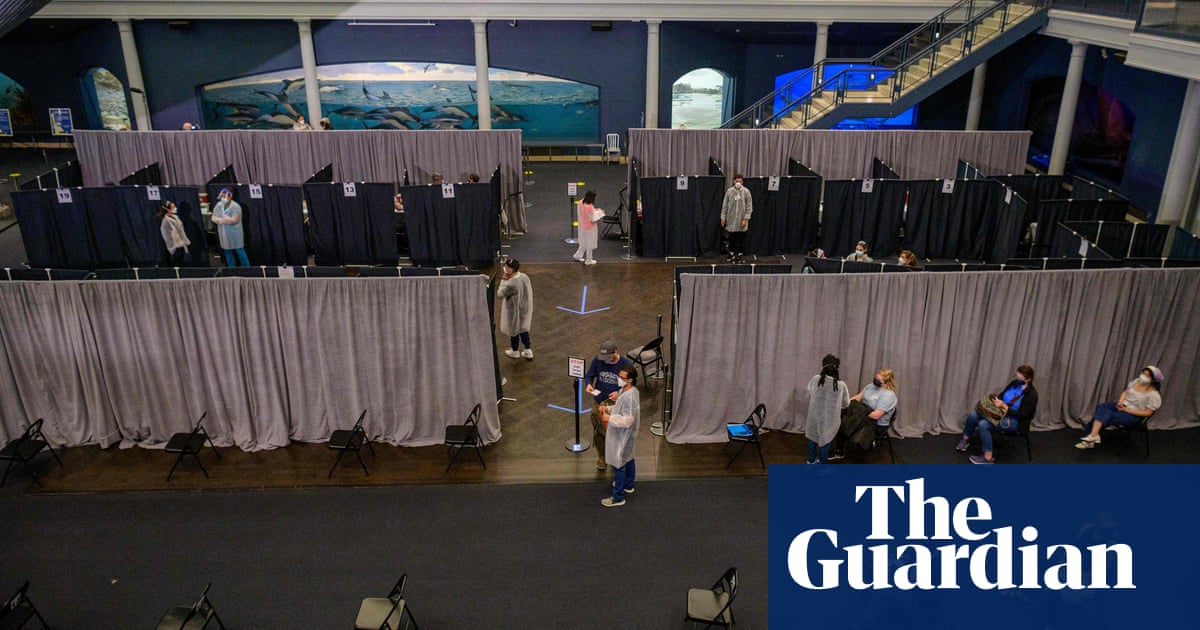You are here
With less than one-third of Americans fully vaccinated, health authorities switch from mass vaccination clinics to outreach campaigns
Primary tabs
 Decline in US Covid vaccinations presents new problem: how to shrink operations With less than one-third of Americans fully vaccinated, health authorities switch from mass vaccination clinics to outreach campaigns the Guardian
Decline in US Covid vaccinations presents new problem: how to shrink operations With less than one-third of Americans fully vaccinated, health authorities switch from mass vaccination clinics to outreach campaigns the Guardian A decline in daily Covid-19 vaccination rates has left US public health authorities with a new problem – how to effectively shrink operations.
In the campaign to immunize all American adults against the coronavirus, most of the difficulties to date have involved overwhelming demand and restricted supply. Now, with less than one-third of Americans fully vaccinated, local public health authorities described a sense of whiplash as they pivot from mass vaccination clinics to outreach campaigns, all within a couple of weeks.
“We knew that when folks became eligible the vaccine-ready folks, or eager, [would] come out right away,” said Mary Jo Brogna, director of nursing at Harbor Health Services, which runs a community clinic in Cape Cod, Massachusetts.
“Reaching the final percentage of herd immunity,” believed to be at least 70% of all adults, “is going to be dependent on outreach and addressing any vaccine hesitancy,” said Brogna.
For most of 2021, the story of the vaccine campaign has been overwhelming demand. Emergency authorities took over stadiums, big-box stores and community centers staffed with dozens of nurses and volunteers to inoculate thousands of people per day.
But in the last two weeks daily vaccination rates in the US have peaked and declined from a high of 3.2m daily vaccine administrations per day to 2.5m. Now, health authorities nationally are experiencing what red states such as Mississippi and Wyoming began to see early signs of – a major slowdown.
“Across the country we started out with mass clinics and those mass clinics worked very well for the older individuals,” said Gary Edwards, executive director of the Salt Lake County health department in Utah.
However, he said, “we’ve reached a point, and it’s been very interesting how quick that happened, that the mass-clinic model is not reaching the segment of the population we’re trying to reach,” said Edwards.
The phenomenon is repeated across the country. Local authorities in Los Angeles, California; Colorado; Florida; Nevada and Texas are poised to close mass vaccination sites by the end of May.
Georgia has already decided to shut down all of its mass vaccination sites by the end of May, citing lack of demand. The state is far behind the nation in terms of administering vaccines, with 34% of the population having received at least one dose, compared with 43% nationally. ...
The reasons for the slowdown are nuanced, most experts said.
Vaccine hesitancy, especially among conservatives and racial minorities, is playing a role. But so too are difficulties with scheduling and transportation, as working-aged adults have fallen far behind older adults in terms of vaccination rates.
One of the most notable trends in the immunization campaign is the relatively low rates of vaccination among adults aged 18-49. In this age group, 9-12% of people are fully vaccinated, compared with more than 27% among people aged 50-64.
Also notable is the lack of uptake in conservative regions. Data from the CDC shows states across the south and west have the highest levels of vaccine hesitancy, and uptake is notably low across these states. Multiple polls have now found Republicans are more likely to say they will not get vaccinated.
“Reaching those young Republicans and conservative groups becomes a priority, because it’s the difference between normalcy or something less,” said Dr Peter Hotez, a vaccine researcher and the dean of the National School of Tropical Medicine at Baylor College in Houston, Texas. Lack of vaccine uptake, he said, “is not going to be homogeneously distributed. That means Covid-19 becomes a red state disease”. ...



Recent Comments